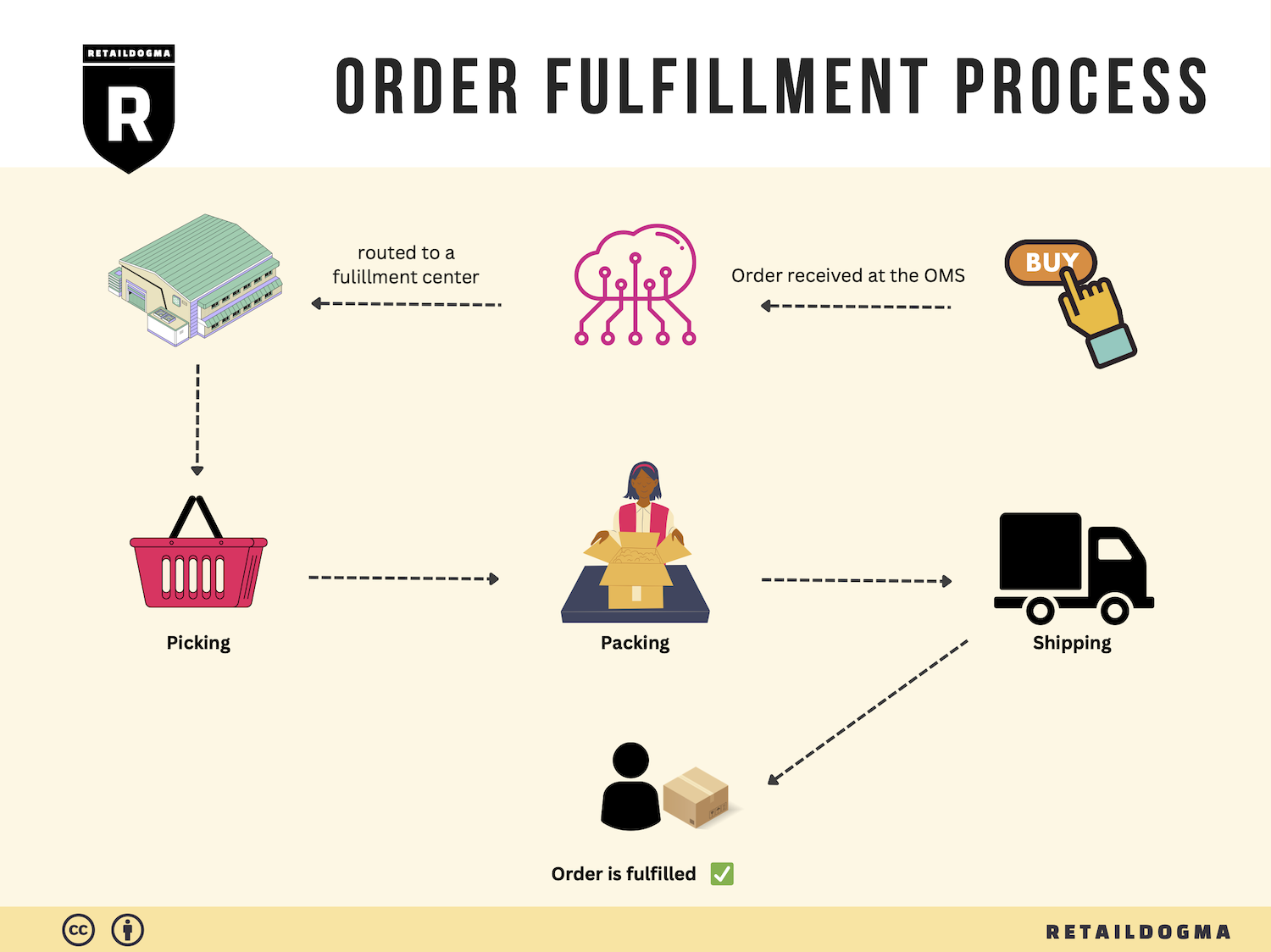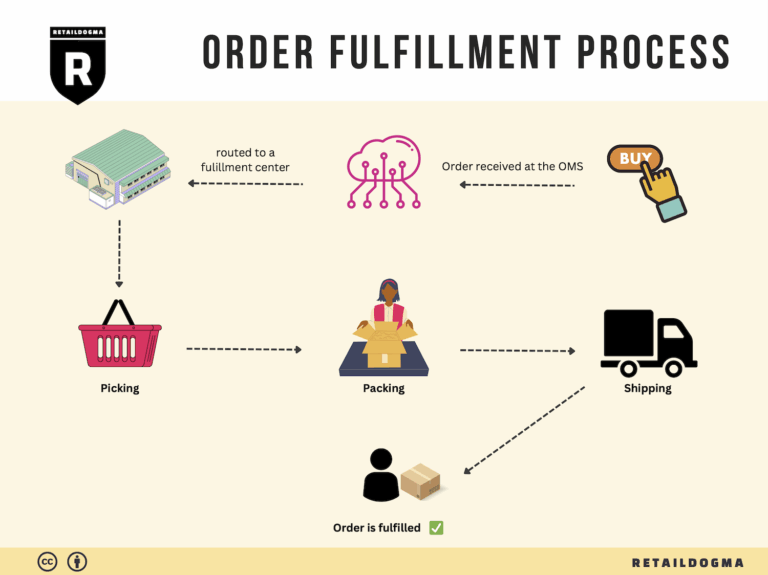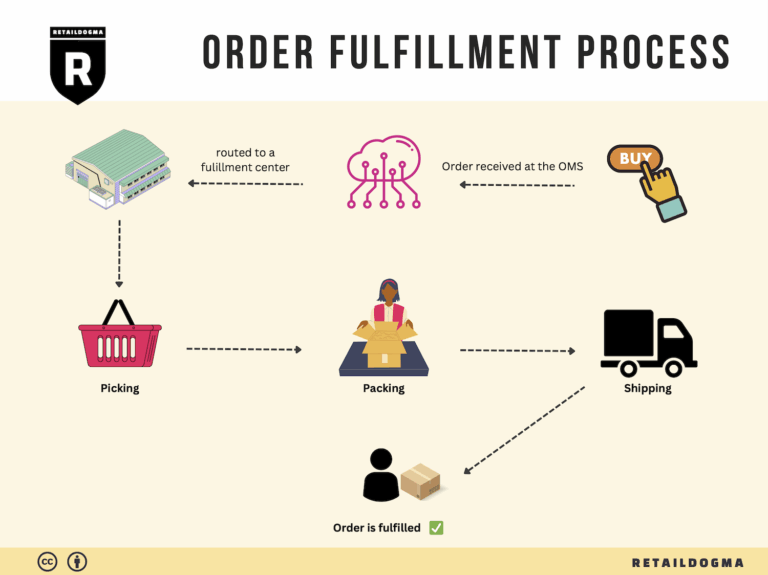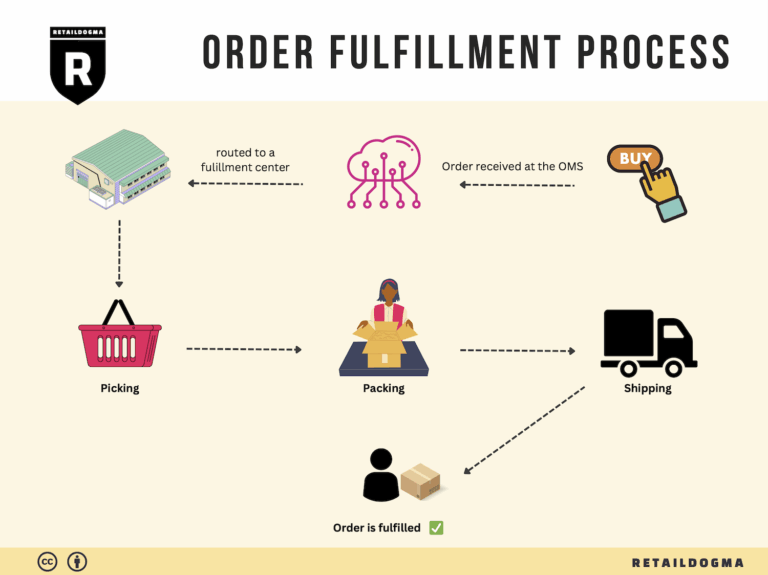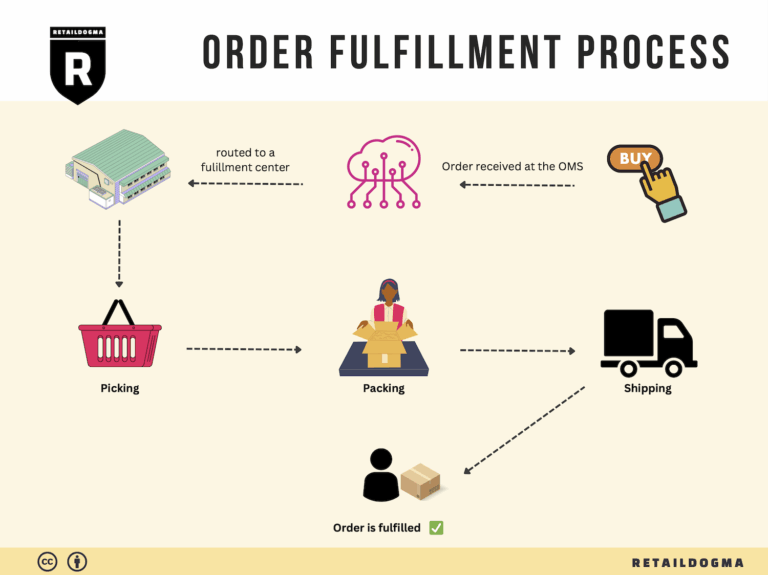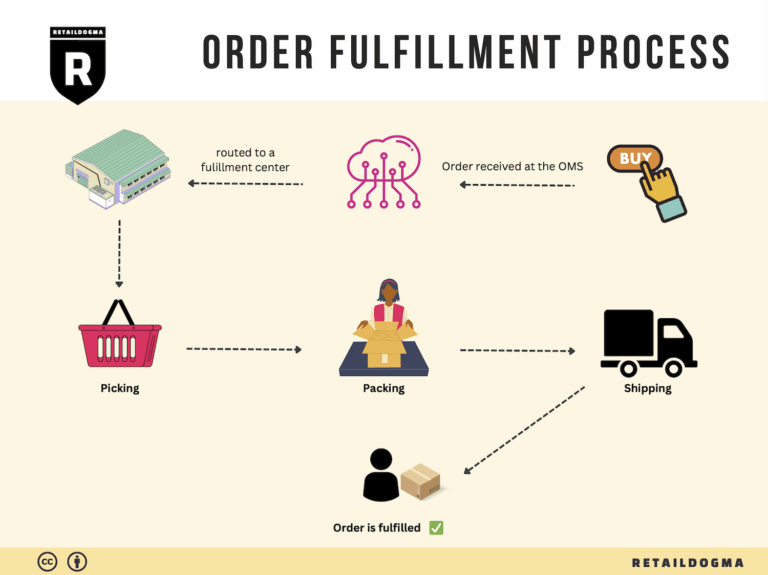Ecommerce Fulfillment Services: The Ultimate Guide (2025)
What is E-commerce Fulfillment? An Introduction for Growing Businesses
Understanding the Fulfillment Challenge
As your online business starts to gain traction, you might find yourself grappling with a common pain point: the overwhelming task of packing and shipping orders. What once felt manageable can quickly become a logistical nightmare as order volumes rise. This scenario often leads to frustration, errors in shipping, and ultimately, dissatisfied customers.
E-commerce fulfillment, at its core, is the process of getting a product from your warehouse or fulfillment center to your customer’s doorstep. It encompasses everything from inventory management to order processing, shipping, and handling returns. For growing businesses, mastering this process is not just beneficial—it’s essential for sustaining growth and maintaining a competitive edge.
What This Guide Covers
In this guide, we will delve into the various facets of e-commerce fulfillment that every growing business needs to understand:
-
Fulfillment Models: Explore different fulfillment models, including Third-Party Logistics (3PL) and Fulfillment by Amazon (FBA). We’ll discuss the advantages and drawbacks of each model to help you determine the best fit for your business needs.
-
Core Services: We’ll break down the essential services involved in the fulfillment process, such as inventory management, order picking and packing, shipping logistics, and returns processing. Understanding these components will enable you to streamline operations and enhance customer satisfaction.
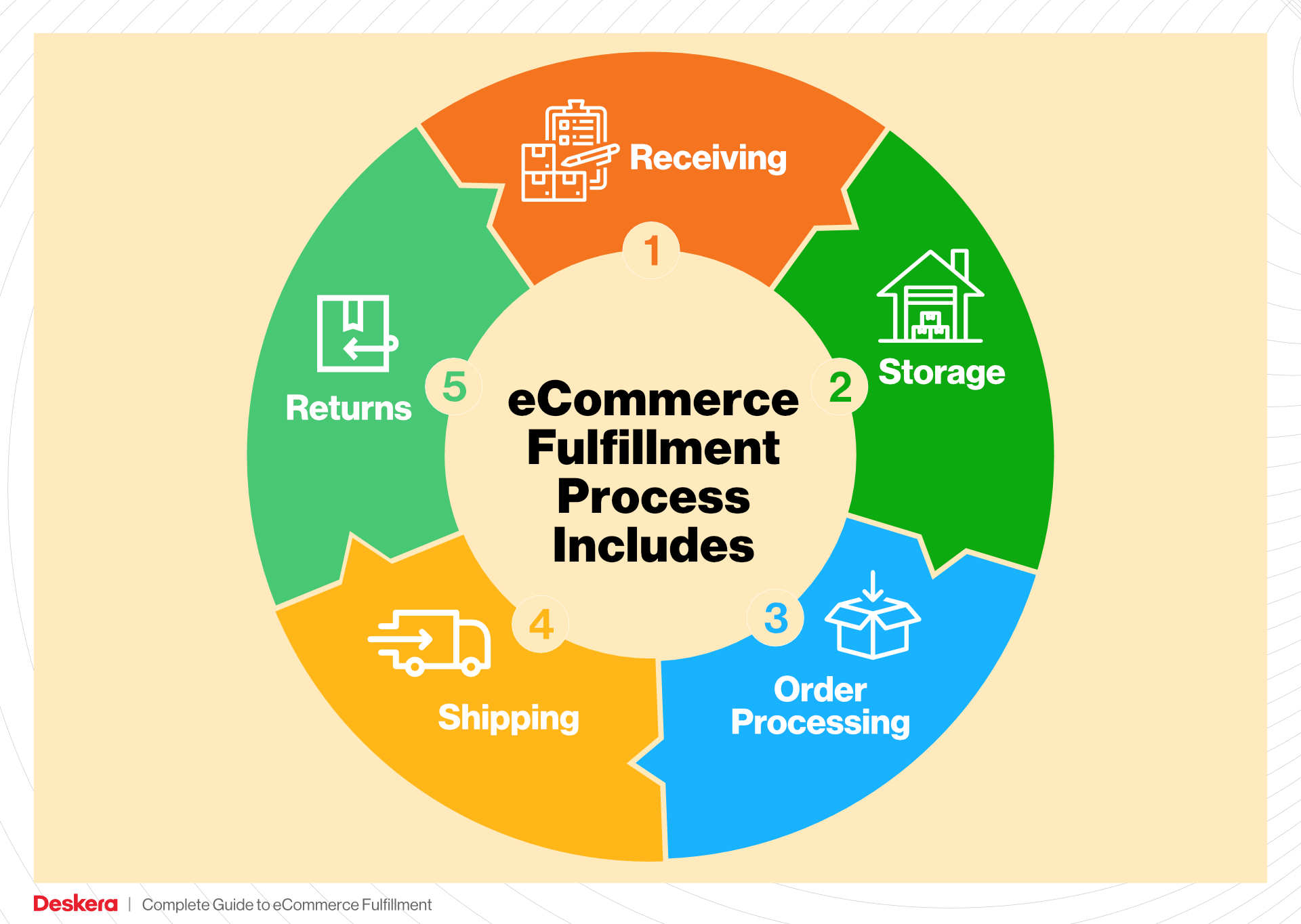
-
Choosing a Partner: Selecting the right fulfillment partner can make or break your logistics strategy. We’ll provide practical tips on what to look for in a fulfillment provider, from technology integration to warehouse locations and customer service capabilities.
-
Pricing Structures: Fulfillment can significantly impact your bottom line. We’ll explain the various pricing structures you might encounter, helping you budget effectively and avoid hidden costs.
Empowering Smart Decisions
Our goal with this guide is to empower your business to make informed decisions about your logistics and fulfillment strategies. By understanding the ins and outs of e-commerce fulfillment, you can optimize your operations, enhance your customer experience, and ultimately drive growth. Whether you’re just starting or looking to scale, this guide will serve as a comprehensive resource to navigate the complexities of e-commerce fulfillment with confidence.
What You’ll Learn In This Guide
- What is E-commerce Fulfillment? An Introduction for Growing Businesses
- The Order Fulfillment Process: From ‘Buy’ Button to Customer’s Door
- Comparing Fulfillment Models: In-House vs. 3PL vs. Dropshipping
- A Deep Dive into Amazon FBA: Pros, Cons, and Who It’s For
- Core Services Offered by Fulfillment Centers
- How to Choose a Fulfillment Partner: A 6-Point Checklist
- Understanding Fulfillment Pricing: A Breakdown of Common Fees
- Frequently Asked Questions (FAQs) about Fulfillment
- Conclusion: Is Outsourcing Fulfillment the Right Move for Your Business?
- Important Disclaimer
The Order Fulfillment Process: From ‘Buy’ Button to Customer’s Door
1. Receiving Inventory
The order fulfillment process begins with receiving inventory, a crucial step where products arrive at the fulfillment center. This involves unloading shipments from suppliers and logging them into the warehouse management system (WMS). To ensure accuracy, businesses should provide an Advance Shipping Notice (ASN) to inform the warehouse of the expected items, quantities, and arrival times.
Receiving is vital because it sets the foundation for inventory accuracy. If goods are not properly logged, it can lead to discrepancies that affect order fulfillment and customer satisfaction. Damaged items or incorrect quantities can be identified at this stage, preventing future issues. Efficient receiving processes can significantly enhance inventory turnover and minimize lost sales opportunities.
2. Warehouse Storage
Once the inventory is received and logged, it is stored in the fulfillment center. This step involves strategically placing products on shelves according to a well-defined storage system. Effective warehousing practices ensure that items are easily accessible for picking and packing.
The importance of warehouse storage lies in its impact on operational efficiency. A well-organized warehouse reduces the time spent searching for items and minimizes the chances of picking errors. Common storage strategies include organizing products by sales volume, where high-demand items are placed closer to the packing area, and using barcoding systems for easy identification. Proper inventory management during this phase helps maintain an optimal stock level, balancing availability with storage costs.
3. Order Picking
The next step in the fulfillment process is order picking, where items are selected from the warehouse to fulfill customer orders. When a customer places an order, the WMS generates a pick list, which details the items and their specific locations within the warehouse. This list is essential for guiding pickers through the storage area efficiently.
Order picking is crucial as it directly influences order accuracy and speed. The faster and more accurately items are picked, the quicker the order can be packed and shipped, enhancing customer satisfaction. Different picking methods, such as zone picking or wave picking, can be employed based on the warehouse size and order volume, allowing businesses to optimize this process further. Implementing best practices in picking can lead to a significant reduction in fulfillment errors and improved operational efficiency.
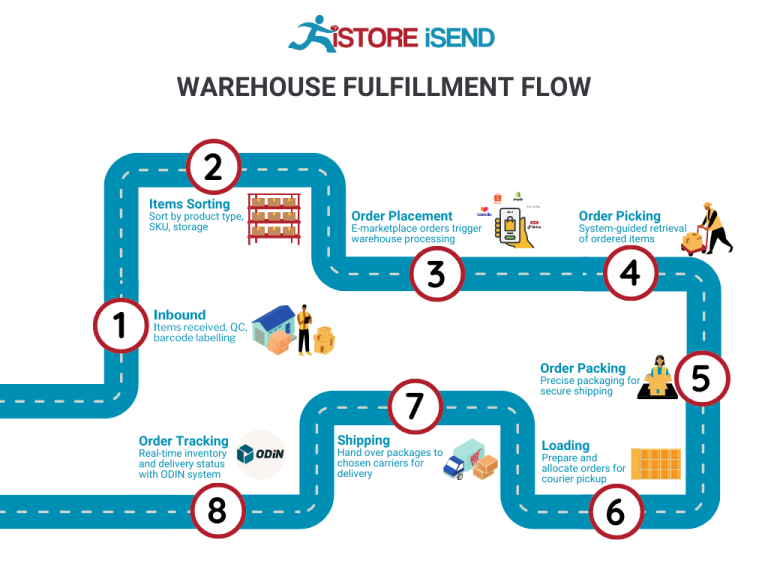
4. Order Packing
After picking, the next phase is order packing, where selected items are securely packed for shipping. This involves determining the appropriate box size, adding protective materials, sealing the package, and applying shipping labels. Efficient packing ensures that products arrive at the customer’s door in pristine condition.
Packing is vital for preventing damage during transit and optimizing shipping costs. A well-packed order reduces the risk of returns and enhances customer satisfaction, as it reflects a business’s attention to detail. Additionally, using packing slips and ensuring that the right items are included in the shipment are critical steps in this process. An effective packing strategy can also contribute to sustainability efforts by minimizing excess packaging materials.
5. Shipping & Delivery
The final step in the fulfillment process is shipping and delivery, where packed orders are handed off to carriers for delivery to the customer. This involves checking shipping labels, organizing packages for pickup, and selecting the most suitable carrier based on speed and cost.
Shipping is a pivotal aspect of the customer experience. Timely delivery can significantly impact customer satisfaction and loyalty. Businesses should consider using multiple carriers to provide flexibility and options for customers. Choosing strategically located warehouses can also shorten delivery times and reduce shipping costs. Furthermore, providing tracking information enhances transparency and allows customers to monitor their orders, further improving their experience.
In conclusion, each step of the order fulfillment process, from receiving inventory to shipping and delivery, plays a critical role in the overall efficiency and effectiveness of an e-commerce operation. By understanding and optimizing these steps, businesses can improve their logistics, enhance customer satisfaction, and ultimately drive growth.
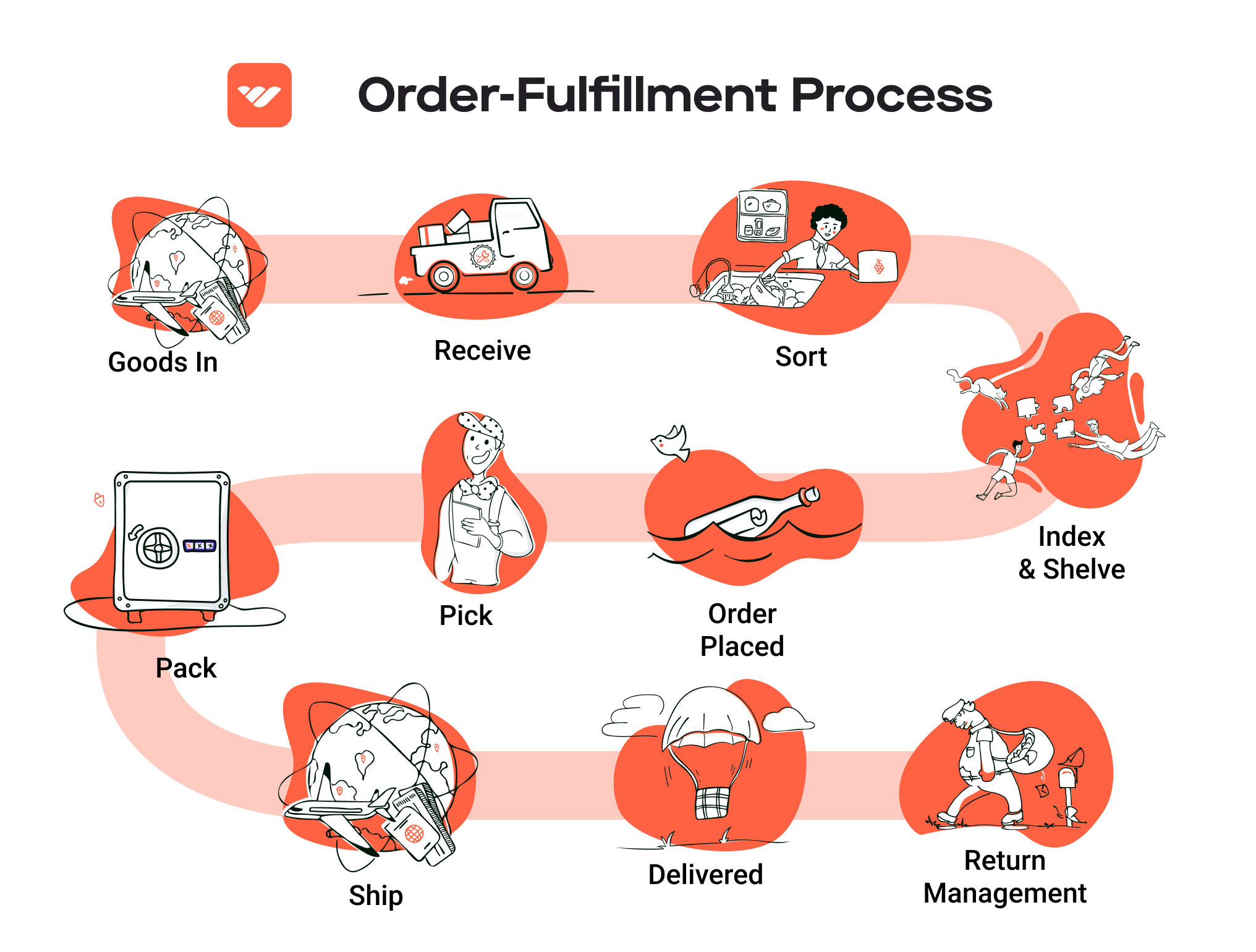
Comparing Fulfillment Models: In-House vs. 3PL vs. Dropshipping
Fulfillment Model Comparison
| Model | Who Handles Inventory | Best For (Business Stage) | Key Advantage | Key Disadvantage |
|---|---|---|---|---|
| In-House Fulfillment | The business itself | Startups to medium-sized businesses | Full control over inventory and operations | High overhead costs and complexity |
| Third-Party Logistics (3PL) | A third-party provider | Growing businesses | Scalability and expertise in logistics | Less control over inventory |
| Dropshipping | Supplier or manufacturer | Startups and niche markets | Low initial investment and risk | Lower profit margins and longer shipping times |
In-House Fulfillment
In-house fulfillment involves managing the entire order fulfillment process within your own organization. This model is ideal for startups and medium-sized businesses that want to maintain complete control over their inventory and operations. By handling fulfillment in-house, businesses can ensure quality control and a personalized customer experience, as they have direct oversight of each order’s processing. However, this model comes with significant challenges. The overhead costs can be substantial, encompassing warehousing, staffing, and technology investments. Additionally, as order volumes grow, managing logistics can become increasingly complex, requiring advanced systems and processes that may divert focus from core business activities. For businesses that are scaling, it may become impractical to continue fulfilling orders in-house without investing heavily in infrastructure.
Third-Party Logistics (3PL)
Third-party logistics (3PL) is a model where businesses outsource their fulfillment operations to specialized providers. This option is particularly beneficial for growing businesses that want to scale quickly without the burden of managing logistics themselves. 3PL providers offer expertise in warehousing, inventory management, order processing, and shipping, allowing businesses to leverage their capabilities for faster and more efficient fulfillment. A key advantage of this model is scalability; as demand increases, businesses can easily adjust their logistics without needing to invest in additional infrastructure. However, outsourcing fulfillment means that businesses have less control over inventory and the customer experience. Additionally, choosing the wrong 3PL partner can lead to fulfillment errors or delays, which can negatively impact customer satisfaction. Businesses must carefully evaluate potential partners to ensure they align with their operational needs and customer service expectations.
Dropshipping
Dropshipping is a fulfillment model where the retailer does not hold inventory but instead transfers customer orders directly to a supplier or manufacturer, who then ships the products to the customer. This model is particularly attractive for startups and niche markets, as it requires a low initial investment and allows entrepreneurs to test product viability without the risk of unsold inventory. The primary advantage of dropshipping is the minimal financial risk involved; businesses only pay for products after they have been sold. However, dropshipping comes with its own set of challenges. Profit margins can be thinner compared to other fulfillment models due to higher per-item costs from suppliers. Additionally, shipping times can be longer, as products may come from various locations, leading to potential delays that can frustrate customers. Businesses must also navigate the complexities of managing relationships with suppliers and ensuring product quality, which can be less predictable than in-house or 3PL arrangements.
Conclusion
Choosing the right fulfillment model is critical for e-commerce businesses looking to scale effectively. Each model—In-House Fulfillment, Third-Party Logistics, and Dropshipping—has its unique advantages and disadvantages. The decision should be based on factors such as business size, growth strategy, financial resources, and customer service priorities. By carefully evaluating these models, e-commerce businesses can align their fulfillment strategy with their overall operational goals, ensuring they can meet customer expectations while optimizing costs and resources.
A Deep Dive into Amazon FBA: Pros, Cons, and Who It’s For
Understanding Fulfillment by Amazon (FBA)
Fulfillment by Amazon (FBA) is a service offered by Amazon that enables sellers to store their products in Amazon’s fulfillment centers. Amazon then takes care of storage, packaging, and shipping, allowing sellers to focus on other aspects of their business. When a customer orders a product, Amazon handles the entire fulfillment process, including customer service and returns. This system is designed to streamline e-commerce operations and provide sellers with the opportunity to leverage Amazon’s vast logistics network.
How FBA Works
-
Inventory Storage: Sellers send their products to Amazon’s fulfillment centers. Amazon stores the inventory until it sells.
-
Order Processing: Once a customer places an order, Amazon’s systems take over. The order is processed through Amazon’s advanced warehouse management systems (WMS), which generate pick lists and coordinate the picking and packing of items.
-
Shipping: After packing, Amazon ships the product directly to the customer. The shipping is typically fast, often eligible for Amazon Prime delivery, which can significantly enhance the customer experience.
-
Customer Service and Returns: Amazon also handles customer service inquiries and processes returns on behalf of the seller, further simplifying the seller’s operational responsibilities.
Pros of Using FBA
1. Prime Eligibility
One of the most significant advantages of FBA is the eligibility for Amazon Prime. Products fulfilled through FBA qualify for Prime, which attracts millions of loyal customers who prefer faster, free shipping. This can lead to increased sales and higher conversion rates.
2. Customer Trust
Amazon is a well-established brand that customers trust. Using FBA can enhance a seller’s credibility, as customers feel more secure purchasing items that are fulfilled by Amazon. This trust can lead to higher sales volumes and potentially better reviews.
3. Multi-Channel Fulfillment
FBA allows sellers to fulfill orders from other sales channels, such as their own websites or other e-commerce platforms. This means sellers can leverage Amazon’s logistics capabilities for all their orders, creating a more efficient fulfillment process across various channels.
4. Simplified Logistics
By outsourcing logistics to Amazon, sellers can focus on growing their business instead of managing inventory, shipping, and customer service. This can lead to significant time savings and allow for a sharper focus on marketing and product development.
5. Advanced Analytics and Reporting
Sellers using FBA have access to Amazon’s analytics tools, which provide insights into sales trends, inventory levels, and customer behavior. This data can be invaluable for making informed business decisions and optimizing inventory management.
Cons of Using FBA
1. High Fees
FBA comes with a variety of fees, including storage fees for keeping products in Amazon’s warehouses and fulfillment fees for each order processed. These costs can add up quickly, especially for low-margin products, potentially eating into profits.
2. Strict Inventory Rules
Amazon has stringent inventory management policies that sellers must adhere to. This includes guidelines on storage limits, product condition, and packaging requirements. Non-compliance can lead to additional fees or even suspension of selling privileges.
3. Commingling Risks
With FBA, products from multiple sellers may be stored together, a practice known as commingling. This can lead to issues such as receiving returns for items that were not yours or selling products that may have been damaged or tampered with. While Amazon offers a solution to opt-out of commingling, many sellers still find it risky.
4. Limited Control Over Fulfillment
By relying on Amazon for fulfillment, sellers relinquish some control over the shipping process. This can lead to inconsistencies in shipping times and packaging quality, which may not align with the seller’s brand standards.
5. Inventory Management Challenges
Managing inventory levels can be challenging with FBA. Sellers need to monitor stock levels closely to avoid stockouts or overstock situations, both of which can lead to lost sales or increased storage fees.
Who is FBA Best For?
Fulfillment by Amazon is particularly well-suited for:
-
New Sellers: Entrepreneurs who are just starting and may not have the infrastructure to handle logistics can benefit significantly from FBA’s streamlined processes.
-
Small to Medium-Sized Businesses: Companies looking to scale quickly without investing heavily in warehousing and logistics can leverage FBA to grow their sales without the operational burden.
-
Sellers with High Turnover Products: If your products have a high turnover rate and can benefit from Prime eligibility, FBA can help maximize sales and minimize storage costs.
-
Brands Seeking Credibility: For sellers wanting to establish or enhance their brand credibility, using FBA can provide the trust factor associated with Amazon’s fulfillment.
-
Multi-Channel Sellers: Businesses selling on multiple platforms can use FBA to simplify their logistics and offer consistent shipping experiences across all channels.
In summary, Fulfillment by Amazon presents a powerful opportunity for e-commerce sellers to streamline operations and enhance customer satisfaction. However, it’s essential to weigh the benefits against the potential drawbacks to determine if FBA aligns with your business goals.
Core Services Offered by Fulfillment Centers
Inventory Management & Warehousing
Inventory management and warehousing are the backbone of any successful fulfillment operation. This service involves the systematic storage, organization, and monitoring of stock to ensure that products are available when customers place orders. Fulfillment centers utilize sophisticated Warehouse Management Systems (WMS) to track inventory levels in real-time, manage stock locations, and facilitate efficient picking processes.
Benefits:
1. Optimized Stock Levels: Effective inventory management helps e-commerce businesses maintain optimal stock levels, reducing the risk of stockouts or overstock situations. This balance is crucial for maintaining cash flow and meeting customer demand.
-
Improved Accuracy: Advanced WMS technology minimizes human error by automating inventory tracking and updates. This accuracy helps prevent order fulfillment issues that could lead to customer dissatisfaction.
-
Space Efficiency: Fulfillment centers are designed to maximize storage space, utilizing vertical storage and organized shelving. This allows businesses to store more products in less space, reducing overall warehousing costs.
-
Quick Turnaround: By streamlining the warehousing process, fulfillment centers can ensure that products are stored and retrieved quickly, enabling faster order processing and shipping times, which are critical for customer satisfaction.
Pick and Pack Services
Pick and pack services involve the selection (picking) of items from warehouse shelves to fulfill customer orders and then packaging (packing) those items securely for shipment. This process is essential for ensuring that the right products reach the customer in perfect condition.
Benefits:
1. Efficiency: Fulfillment centers employ various picking methods, such as zone picking and wave picking, to streamline the order fulfillment process. This efficiency translates to faster order processing times, which is vital for meeting customer expectations in today’s fast-paced e-commerce environment.
-
Scalability: As your e-commerce business grows, the demand for your products may fluctuate. Fulfillment centers can easily scale their pick and pack services to meet increased order volumes, allowing you to focus on growth without worrying about logistics.
-
Custom Packaging Options: Fulfillment centers often provide tailored packaging solutions to enhance the customer unboxing experience. This attention to detail can improve brand loyalty and customer satisfaction.
-
Error Reduction: By utilizing technology and systematic processes, fulfillment centers significantly reduce the likelihood of picking errors. This accuracy not only enhances customer satisfaction but also minimizes return rates, which can be costly for e-commerce businesses.
Kitting and Assembly
Kitting and assembly services involve the process of grouping individual items into ready-to-sell sets or kits. This could include bundling related products together or assembling components into a final product. For example, a fulfillment center might create a gift set that includes various items or assemble parts for a product that is sold as a unit.
Benefits:
1. Value-Added Services: Kitting allows e-commerce businesses to offer unique product bundles, increasing perceived value and encouraging customers to purchase more. This strategy can enhance average order value and drive sales.
-
Streamlined Operations: By outsourcing kitting and assembly to fulfillment centers, businesses can save time and resources. This allows internal teams to focus on core business functions such as marketing and customer service.
-
Customization Flexibility: Fulfillment centers can accommodate various kitting requirements, allowing businesses to launch seasonal promotions or limited-time offers without the need for extensive in-house resources.
-
Inventory Control: Kitting can help manage inventory more effectively by combining slow-moving items with popular products, reducing excess stock and improving turnover rates.
Returns Management (Reverse Logistics)
Returns management, or reverse logistics, is a critical service offered by fulfillment centers that focuses on handling product returns efficiently. This process includes receiving returned items, inspecting them, restocking sellable products, and managing the disposal of unsellable goods.
Benefits:
1. Enhanced Customer Experience: A well-managed returns process can significantly improve customer satisfaction. Offering hassle-free returns encourages customers to shop with confidence, knowing they can return items easily if needed.
-
Cost Efficiency: Fulfillment centers that specialize in returns management can minimize the costs associated with processing returns. By efficiently sorting and restocking items, they help businesses recover value from returned products.
-
Data Insights: Returns management provides valuable data on customer behavior and product performance. Analyzing return trends can help businesses make informed decisions about product offerings and inventory management.
-
Sustainability Initiatives: Many fulfillment centers have processes in place for recycling or donating returned items that cannot be resold. This approach not only reduces waste but also enhances the brand’s reputation as a socially responsible business.
In summary, partnering with a fulfillment center that offers comprehensive services such as inventory management, pick and pack, kitting, and returns management is essential for e-commerce businesses looking to scale. These services not only streamline operations but also enhance customer satisfaction, ultimately driving sales and growth.
How to Choose a Fulfillment Partner: A 6-Point Checklist
Location & Warehouse Network
Importance: The geographical location of your fulfillment partner’s warehouses can significantly impact shipping times and costs. A strategically placed warehouse network enables faster deliveries to your customer base, which is crucial for maintaining a competitive edge in e-commerce.
Questions to Ask:
– Where are your warehouses located, and how do these locations align with my customer demographics?
– Can you provide shipping times and costs for my primary markets?
– Do you have plans for expanding your warehouse network in the near future?
Technology & Integrations
Importance: Efficient order fulfillment relies heavily on technology. Your fulfillment partner should utilize a robust Warehouse Management System (WMS) that integrates seamlessly with your e-commerce platform. This ensures real-time inventory management, accurate order processing, and enhanced visibility throughout the supply chain.
Questions to Ask:
– What technology do you use for order management and inventory tracking?
– How does your WMS integrate with major e-commerce platforms (e.g., Shopify, Magento, WooCommerce)?
– Can you provide real-time reporting and analytics? What KPIs do you track?
Specializations (e.g., cold storage, oversized items)
Importance: Depending on your product offerings, you may require specialized fulfillment services. For example, if you sell perishable goods, your partner must have cold storage capabilities. Similarly, oversized or fragile items may need unique handling and storage solutions.
Questions to Ask:
– What specializations do you offer that align with my product types?
– Can you handle specific requirements such as temperature control, hazardous materials, or oversized items?
– What protocols do you have in place for managing returns of specialized products?
Scalability & Capacity
Importance: As your business grows, your fulfillment needs will evolve. It’s essential to choose a partner that can scale with your business, whether that means increasing storage space, processing higher order volumes, or expanding into new markets.
Questions to Ask:
– What is your current capacity for handling orders, and how do you accommodate seasonal spikes in demand?
– How quickly can you scale your operations if my order volume increases?
– Are there any limitations to your scalability that I should be aware of?
Pricing and Contracts
Importance: Understanding the pricing structure and contract terms of your fulfillment partner is vital for budgeting and financial planning. Look for transparency in pricing, including storage fees, shipping costs, and any additional charges that may apply.
Questions to Ask:
– Can you provide a detailed breakdown of your pricing structure?
– Are there any hidden fees I should be aware of (e.g., for storage, returns, or special handling)?
– What are the terms of the contract, and is there flexibility in case my needs change?
Customer Support & Reviews
Importance: Reliable customer support can make or break your relationship with a fulfillment partner. A partner with excellent customer service can quickly resolve issues that arise, ensuring minimal disruption to your operations. Additionally, researching reviews can provide insights into the partner’s reliability and performance.
Questions to Ask:
– What level of customer support do you provide? Is there a dedicated account manager?
– What are your response times for support inquiries?
– Can you provide references or case studies from businesses similar to mine? What do online reviews say about your services?
Conclusion
Selecting the right fulfillment partner is a critical decision that can greatly influence the success of your e-commerce business. By using this checklist, you can systematically evaluate potential partners, ensuring they align with your operational needs and growth goals. Take the time to ask the right questions, assess their capabilities, and make an informed choice that will support your business’s expansion and customer satisfaction.
Understanding Fulfillment Pricing: A Breakdown of Common Fees
Initial Setup Fees
When engaging a fulfillment service provider, businesses typically encounter initial setup fees. These are one-time charges that cover the costs associated with onboarding your products into the fulfillment system. Setup fees can vary significantly based on the complexity of your product line, the fulfillment provider’s infrastructure, and the level of customization required for your operations.
The calculation of initial setup fees often includes:
– Inventory setup: Costs incurred to input your product data into the warehouse management system (WMS).
– System integration: Fees for connecting your e-commerce platform with the fulfillment center’s systems to ensure seamless order processing.
– Packaging customization: If you require custom branding on packaging materials, this can also contribute to setup costs.
To minimize initial fees, it’s advisable to consolidate your product information and ensure that your e-commerce platform is compatible with the fulfillment service before onboarding.
Receiving Fees
Receiving fees are charged each time your inventory arrives at the fulfillment center. This fee covers the labor and resources needed to unload, inspect, and log your products into the inventory system. Receiving fees can be structured as a flat rate per shipment or calculated based on the volume of goods received.
Factors influencing receiving fees include:
– Volume of products: Larger shipments may incur higher fees due to the increased labor required to process them.
– Condition of the shipment: If items are damaged or need additional handling, extra charges may apply.
– Advance Shipping Notice (ASN): Providing an ASN can streamline the receiving process, potentially reducing costs.
To control receiving fees, ensure that your shipments are well-organized and that you provide accurate ASNs to the fulfillment center.
Storage Fees (per pallet/bin)
Storage fees are recurring charges for keeping your inventory in the fulfillment center. These fees can be calculated on a per-pallet or per-bin basis, depending on the storage method used by the fulfillment provider. The fee structure can vary widely, with some providers offering tiered pricing based on the volume of inventory stored.
Key considerations for storage fees include:
– Inventory turnover: High turnover rates may qualify for lower storage rates, as the provider values quick inventory movement.
– Seasonal fluctuations: During peak seasons, storage fees may rise if your inventory levels increase significantly.
– Duration of storage: Longer storage times can lead to increased fees, especially if your products are not selling.
To manage storage costs effectively, analyze your sales trends and adjust inventory levels accordingly, avoiding overstocking.
Pick & Pack Fees (per item/order)
Pick and pack fees are charged for the labor involved in retrieving products from storage and preparing them for shipment. These fees can be assessed on a per-item or per-order basis, depending on the fulfillment provider’s pricing model. The complexity of the order can also affect the fee structure.
Factors that influence pick and pack fees include:
– Order complexity: Orders with multiple SKUs may incur higher fees due to the additional time and labor required for picking.
– Packaging requirements: Special packaging needs, such as gift wrapping or custom inserts, can also lead to increased costs.
To optimize pick and pack fees, streamline your product offerings and consider standardizing packaging materials for efficiency.
Shipping Fees
Shipping fees are charged for the delivery of packages to customers and can vary based on several factors, including the shipping method selected, package dimensions, weight, and destination. Fulfillment providers often have partnerships with multiple carriers, allowing businesses to choose the most cost-effective options for their needs.
Shipping fees can be influenced by:
– Distance: Longer distances typically incur higher shipping costs.
– Carrier selection: Different carriers may offer various pricing structures based on their delivery speed and service levels.
– Weight and dimensions: Heavier and bulkier packages generally cost more to ship.
To minimize shipping fees, evaluate different carriers and consider implementing flat-rate shipping for your customers, which can simplify pricing.
Tips for Getting an Accurate Quote
-
Provide Detailed Information: When seeking quotes, be as specific as possible about your product dimensions, weights, and order volumes. This helps fulfillment providers give you a tailored estimate.
-
Ask About Hidden Fees: Inquire about any potential hidden fees associated with your fulfillment services, such as additional charges for returns or special handling.
-
Compare Multiple Providers: Don’t settle for the first quote. Compare several fulfillment providers to gauge the market rate and ensure you’re getting the best deal.
-
Negotiate Terms: Many fulfillment centers are open to negotiation, especially if you can demonstrate consistent order volumes or long-term potential.
-
Review Contracts Thoroughly: Before signing, carefully review the contract to ensure that all fees are transparent and well-defined.
By understanding these common fulfillment fees and how they are calculated, e-commerce business owners can make informed decisions that enhance their operational efficiency and profitability.
Frequently Asked Questions (FAQs) about Fulfillment
1. What is ecommerce fulfillment?
Ecommerce fulfillment encompasses the entire process of receiving, storing, picking, packing, and shipping products to customers after they place an order online. It also includes managing returns and inventory. A well-optimized fulfillment strategy is crucial for ensuring timely delivery and customer satisfaction.
2. What’s the difference between a warehouse and a fulfillment center?
A warehouse primarily focuses on the storage of goods, while a fulfillment center specializes in processing and shipping orders. Fulfillment centers often have advanced technology for inventory management, order processing, and returns handling, enabling them to operate efficiently for e-commerce businesses.
3. What is a 3PL (Third-Party Logistics)?
A 3PL provider offers outsourced logistics services, including warehousing, fulfillment, and shipping. By partnering with a 3PL, e-commerce businesses can leverage their expertise, technology, and infrastructure to streamline operations and focus on core business activities, like marketing and sales.
4. How much do fulfillment services cost?
Fulfillment service costs can vary widely based on factors such as order volume, storage space, packaging requirements, and shipping methods. Typical pricing structures include per-order fees, monthly storage fees, and additional charges for services like kitting or returns processing. It’s essential to analyze your specific needs and compare multiple providers to find the best fit.
5. How do I choose the right fulfillment partner?
Selecting the right fulfillment partner involves evaluating their experience, technology capabilities, location, pricing structure, and customer service. Look for a provider that aligns with your business model, offers scalability, and has a proven track record of timely deliveries and efficient returns management.
6. What are the key components of the fulfillment process?
The fulfillment process includes several critical components:
– Receiving products into the warehouse
– Storing inventory effectively
– Picking and packing orders accurately
– Shipping products to customers
– Handling returns efficiently
Each step must be optimized to ensure a seamless experience for both the business and its customers.
7. How can I improve my fulfillment efficiency?
To enhance fulfillment efficiency, consider implementing automation technologies, optimizing warehouse layout, utilizing data analytics for inventory management, and regularly reviewing processes for bottlenecks. Training staff and establishing clear standard operating procedures (SOPs) can also significantly improve operational efficiency.
8. What is the role of inventory management in fulfillment?
Inventory management is crucial in fulfillment as it ensures that the right amount of products is available to meet customer demand without overstocking. Effective inventory management minimizes storage costs, reduces the risk of stockouts, and enhances order accuracy, ultimately leading to improved customer satisfaction.
9. How do returns impact the fulfillment process?
Returns are an inevitable part of e-commerce and can significantly affect fulfillment operations. A well-defined returns process is essential for managing these returns effectively. This includes deciding whether to process returns in-house or through a 3PL, evaluating returned items, and determining the best course of action for each (restock, repair, or dispose).
10. What are best practices for managing fulfillment during peak seasons?
During peak seasons, such as holidays or sales events, it’s vital to prepare in advance. Best practices include forecasting demand accurately, increasing staffing levels, optimizing inventory levels, and ensuring that your fulfillment partner can scale operations. Communicating clear shipping timelines to customers can also help manage expectations and enhance satisfaction.
Conclusion: Is Outsourcing Fulfillment the Right Move for Your Business?
Evaluating the Benefits of Outsourcing Fulfillment
Outsourcing fulfillment can be a game-changer for e-commerce businesses looking to scale. By partnering with a specialized fulfillment service, you can save valuable time and resources. This allows you to focus on core business activities such as product development, marketing, and customer engagement. Fulfillment providers bring expertise in logistics management, ensuring that orders are processed quickly and accurately, which in turn enhances customer satisfaction and retention.
Scalability is another significant advantage of outsourcing fulfillment. As your business grows, so does the complexity of your logistics. A third-party logistics (3PL) partner can easily adapt to your changing needs, whether it’s managing increased order volumes during peak seasons or expanding your distribution network. This flexibility enables you to grow without the headache of managing logistics in-house.
Moreover, choosing the right fulfillment partner is crucial for your long-term success. Not all fulfillment services offer the same level of expertise or operational capabilities. It’s essential to conduct thorough research and consider factors like shipping times, inventory management, and return processing to find a partner that aligns with your business goals.
Strategic Next Steps
To determine if outsourcing fulfillment is the right move for your business, consider auditing your current shipping and logistics processes. Evaluate areas where inefficiencies exist or where customer feedback indicates a need for improvement. This assessment will provide clarity on whether a fulfillment partner could enhance your operational efficiency and support your growth ambitions.
By taking this proactive approach, you can make an informed decision that positions your business for success in the competitive e-commerce landscape. Don’t hesitate to explore the possibilities that outsourcing fulfillment can offer—your future growth may depend on it.
Important Disclaimer
⚠️ Important Disclaimer
The information in this guide is for educational purposes. Fulfillment services, pricing, and platform features change frequently. Always conduct your own due diligence and consult with providers directly before making business decisions.
